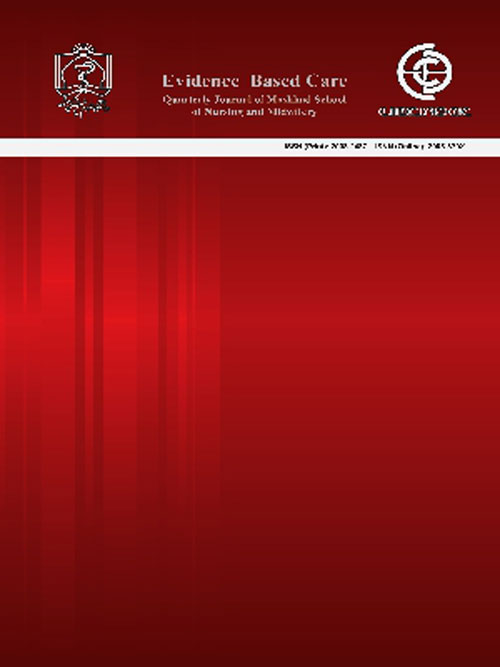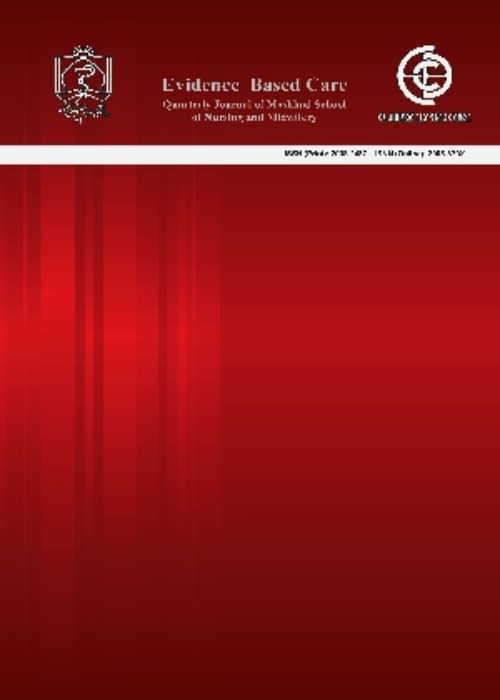فهرست مطالب

Evidence Based Care
Volume:6 Issue: 2, Summer 2016
- تاریخ انتشار: 1395/05/19
- تعداد عناوین: 8
-
-
Pages 7-18BackgroundAs two of the most prominent cultural components, spirituality and religion give sense to our human values, conducts, and experiences. The spiritual dimension is one of the four significant aspects of holistic care. However, the diversity of views has resulted in different interpretations of the reality of spirituality and its origins and consequences.
Aim: This study aimed to examine the available approaches and paradigms in the realm of spirituality.MethodIn the present integrative review, the initial search was performed in national and international databases, including Science Direct, PubMed, Google Scholar, Scopus, Sage, Medline, Wiley, SID, MagIran, IranMedex, and IranDoc, using the keyword, "spirituality", without considering any time limits. Articles relevant to the objectives of the study were then fully reviewed.ResultsSince ancient times, spirituality has been sporadically discussed in human intellectual and artistic artifacts. This concept was expanded as an independent, systematic, and conscious movement since the second half of the 19th century in Europe, USA, and Canada. The three prominent approaches to spirituality include religious, secular, and holistic health perspectives.
Implications for Practice: Despite the growing interest in research on spirituality, it is difficult to reach a unanimous decision about this concept. However, it should be noted that spiritual concerns cannot be disregarded, considering the holistic perspective to humanity as the building block of holistic nursing care. Overall, every patient is a unique human being whose spiritual needs are affected by his/her cultural beliefs and values.Keywords: Spirituality, Religion, Secular, Holistic health -
Pages 19-28BackgroundHundreds of patient education materials i.e. pamphlets are annually published in healthcare systems following their design, correction, and revision.
Aim: to design and evaluate patient education pamphlets based on readability indexes and their comparison with literacy level in society.MethodThe average literacy level among 500 patients admitted to two training hospitals in Bojnurd (northeastern Iran) was determined in 2014-2015. Afterwards, all patient education pamphlets in both hospitals (n=69) were collected and their readability level was determined. After that, all the pamphlets were re-designed according to the given standards and in line with literacy level in society. The SPSS software (Version 20) was also used to analyze the data.ResultsThe average level of literacy among 500 patients in both hospitals in the present study was 6.72±4.34 which was placed in grades six and seven in terms of the guide to readability indexes. In line with McLaughlins SMOG Readability Formula, the bulk of pamphlets (91.3%) were at college level before corrections and revisions based on the given standards, but 23.2% were at a level lower than grade seven following corrections and revisions.
Implications for Practice: Evaluation of patient education pamphlets plays an important role in promoting self-care among patients. Due to the novelty of the present study in Iran, the results of this study can contribute to patient education researchers in order to identify the strengths and weaknesses of patient education materials i.e. pamphlets based on scientific indices as well as their revisions and re-developments.Keywords: Patient education, Pamphlet, Readability Indexes -
Pages 29-38BackgroundLumbar Puncture test is one of the most stressful diagnostic procedures in pediatric ward that its prescription put mothers under extreme pressure. There are limited interventions in this regard.
Aim: determining the impact of supportive educational program on the anxiety of mothers whose children are undergoing lumbar puncture (LP).Methodthe present study is a randomized controlled clinical trial carried out in 2015. Sixty mothers of children undergoing lumbar puncture and hospitalized 3educational hospitals of Mashhad, Iran, were randomly divided to control group (n=30) and intervention group (n=30). The intervention group received supportive program during a session of 60 min. Spielberger State-Trait Anxiety Inventory (STAI) was selected as the research tool. Finally, data were analyzed by Chi-square test, independent t-test using SPSS v.16 software.ResultsThe mean age of the mothers was 27.3±5.3 and 26.0±3.1, respectively. The mean pre-interventions maternal manifest anxiety was 51.9±6.2 and 53.4±4.3 out of 80, respectively, in the intervention and control groups. The mean post-interventions maternal manifest anxiety was 44.9±5.1 and 52.7±4.2, respectively, in the intervention and control groups. According to the results of independent t-test, significant difference was observed statistically for the mean maternal manifest anxiety between the two groups (p> 0.001).
Implications for Practice: Regarding the reduction of maternal anxiety in the intervention group, which is possible because of the attention to the emotional needs of mothers, in addition to proper training; this program can be considered as an effective method to reduce maternal anxiety before the LP test.Keywords: Education, Support, Anxiety, Lumbar puncture -
Pages 39-48BackgroundChronic musculoskeletal pain is a worldwide health problem. Anxiety and depression are common among patients suffering from chronic pain. Self-management strategies are used to help patients manage the emotional distress associated with pain.
Aim: To evaluate the effects of cognitive pain self-management program (CPSMP) on depression, anxiety, and stress in women with chronic pain.MethodThis pilot study with a pretest-posttest design performed on 20 women with chronic pain, who were referred to Imam-Reza and Qaem Clinic Centers and Clinical Psychology Center of Ferdowsi University of Mashhad, Iran, during June-October 2014. The participants randomly assigned to experimental and control groups. The intervention comprised of eight 120-min weekly group sessions. CPSMP employs the principles of cognitive therapy and self-management program strategies. The control group received regular treatment sessions. At pre-and post-test, the participants completed Depression, Anxiety, and Stress Scale (DASS-21). The data were analyzed using Wilcoxon and Mann-Whitney U tests.ResultsThe mean ages of the intervention and control groups were 35.2±9 and 32.5±11 years, respectively. After the intervention, Mann-Whitney U test did not reflect a significant difference between the intervention and control groups in terms of depression (P=0.14). Moreover, the results of Mann-Whitney test revealed a significant difference between the groups regarding anxiety (PImplications for Practice: CPSMP can be effective for reducing anxiety and stress in women with chronic pain. Further studies with larger sample sizes and more extended follow-ups are recommended.Keywords: Chronic pain, Pain management program, Depression, Anxiety, Stress, women -
Pages 49-56BackgroundIn the aftermath of de-institutionalisation and the move to community management of epilepsia, mothers play an increasing role in the management of the illness. Mothers often complain of being misinformed and ill equipped to aid in the treatment.
Aim: The purpose of this study was to investigate the effect of a Supportive Educational Program on self-efficacy of mothers with epileptic children.MethodThis randomized controlled clinical trial was conducted on two groups of 50 mothers with epileptic children admitted to Ghaem Hospital in the city of Mashhad in 2014. Maternal self-efficacy was measured before and 6 weeks after intervention through Steffens Revised Scale for Caregiving Self-Efficacy as the research instrument. The Supportive Educational Program was implemented for the experimental group during five 60-minute sessions with an interval of 4 days. The control group received the routine care. Data analysis was performed using SPSS software (version 11.5).ResultsThe mean age of mothers in the experimental and control groups were 32.8±6.9 and 32.8±6.8 years, respectively. The findings of the independent t-test revealed significant differences between the two control (47.4±15.06) and experimental (66.5±11.5) groups following the intervention (pImplications for Practice: Stepwise implementation of a Supportive Educational Program can contribute to an increase in maternal awareness about how to care, reasons for recurrence, and measures taken in the emergency stage of epilepsy through gradual strengthening of self-efficacy of mothers with epileptic children.Keywords: Education, Self, Efficacy, Epilepsy, Mother, Child -
Pages 57-66BackgroundRespiratory function in patients undergoing open heart surgery is disrupted after surgery. Patient education on managing complications can reduce occurrence or severity of them. A variety of educational tools has been introduced, but there are controversies about the most appropriate tools.
Aim: Determine the effect of instructional videos on respiratory function of the patients after off-pump open heart surgery.MethodThis single-blind randomized clinical trial was conducted on 60 patients undergoing open heart surgery hospitalized at open heart surgery ward of Imam Reza (AS) hospital in Mashhad, Iran, in 2015. The patients were randomly allocated to intervention and control groups of 30 subjects. The instructional video during a 15-minute session was displayed in the intervention group and the control group educated by pamphlet and face-to-face training the day before the surgery. The respiratory function in both groups was assessed before intervention through spirometric variables including forced expiratory volume in 1 second (FEV1) and vital capacity (VC). After surgery, arterial oxygen saturation (SaO2) and PaO2/FiO2 Ratio (PF ratio) were measured 30 minutes after extubation, as well as the variables of FEV1, VC, SaO2 and PF ratio 24 hours after extubation. Data were analyzed by independent t-test, Mann-Whitney, Chi square, paired t-test, Wilcoxon and Friedman using SPSS version 11.5 software.ResultsThe means age of patients were 57.5±4.8 and 56.2±4.2 years in the intervention and the control groups, respectively. The difference of the PF ratio 24 hours after extubation compared to 30 minutes after extubation in the intervention group was significantly higher than the control group (PImplications for Practice: The results suggested superiority of the instructional videos rather than pamphlet and face-to-face training to improve postoperative respiratory function in patients undergoing open heart surgery, indicating that instructional videos considering the patient's educational level and their conditions can be effective in educating patients.Keywords: Instructional Video, Pamphlet, Thoracic Surgery, Respiratory Function Tests, Patient education, Breathing Exercises -
Pages 67-74BackgroundInfants may lose their body resources after surgery due to inadequate nutrient intake and undergoing long periods of fasting after surgery for esophageal atresia, increases risk of several complications.
Aim: This study aimed to evaluate the effects of early feeding support on the postoperative weight gain status of infants with esophageal atresia.MethodThis randomized, controlled clinical trial was conducted on 36 infants with esophageal atresia (type C) selected 48 hours after surgery during July 2015-March 2016 at Dr. Sheikh Hospital of Mashhad, Iran. In the intervention group, detecting no lack of leakage on chest X-ray, feeding was initiated and the control group received routine feeding. Neonatal weight changes were measured daily using a digital scale (TANITA model) since the first day after the surgery and one month after discharge from the hospital. Data was analysed using SPSS version 16 by independent T-test and Chi-square.ResultsMean neonatal weight on admission was 2558.1±337.4 grams in the intervention group and 2547.6±856 grams in the control group (P=0.47). Results of independent T-test showed that daily weight gain before and after feeding was significantly higher in the intervention group compared to the control group (P=0.01). Moreover, weight gain one month after discharge had a significant difference between infants of the intervention and control groups (P=0.03).
Implications for Practice: According to the results of this study, early feeding support could improve the weight index of neonates with esophageal atresia. Considering the possible complications and long-term consequences of surgery, early initiation of feeding could be an appropriate remedial measure in infants with esophageal atresia.Keywords: Esophageal atresia, Oral feeding, Infants, Postoperative care


